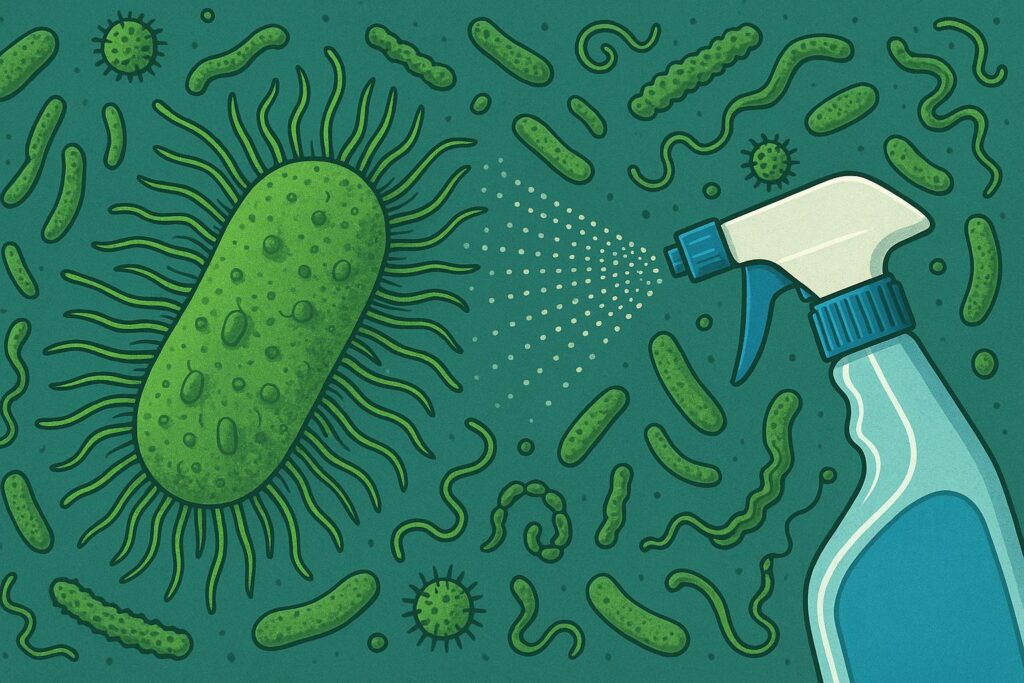Bactericides are essential in modern agriculture for plant protection and crop yield improvement. They control or eliminate harmful bacteria that affect plant health. However, not all bactericides are created equal. Organic and chemical bactericides differ significantly in their composition, mechanism of action, environmental impact, application methods, and long-term implications for soil and plant health.
Understanding these differences is critical for farmers, agronomists, and sustainability-focused growers. This guide breaks down the six essential distinctions between these two types, helping you make informed decisions based on effectiveness, cost-efficiency, and ecological impact.
What Are Bactericides Used For in Agriculture?
Bactericides are agents that suppress or destroy bacterial growth in crops. Farmers use them to:
- Protect against plant diseases like bacterial blight or leaf spot.
- Reduce post-harvest losses in fruits and vegetables.
Bactericides play a critical role in Integrated Pest Management (IPM), especially in climates where bacterial infections spread rapidly. Whether organic or synthetic, bactericides must adhere to safety, residue, and efficacy standards before being used in food production.
1. Composition and Origin of Bactericides
How Do Organic and Chemical Bactericides Differ in Ingredients?
The first fundamental difference lies in their composition.
- Organic bactericides are derived from natural sources such as plant extracts (e.g., neem and thyme oil), minerals like copper sulfate, or biological agents such as Bacillus subtilis and Streptomyces.
- Chemical bactericides are synthetically produced compounds, often including quaternary ammonium salts, antibiotics like streptomycin, or synthetic copper complexes.
While chemical products offer consistency in formulation, organic bactericides often rely on natural variability, affecting performance across different conditions.
Copper-based compounds are used in both types but differ in purity, release rate, and soil interaction depending on whether the product is organic-certified or synthetic.
2. Mode of Action and Residual Behavior
How Do These Bactericides Work Against Plant Pathogens?
Organic bactericides work by:
- Disrupting bacterial membranes using bioactive compounds.
- Promoting antagonistic microbial activity in the phyllosphere and rhizosphere.
Chemical bactericides:
- Directly inhibit bacterial DNA replication or protein synthesis.
- Often act as contact bactericides with persistent surface activity.
While organic alternatives frequently increase microbial diversity and strengthen the plant’s immune responses, chemical alternatives exhibit faster activity.
Bacillus-based bactericides, for instance, have been shown to reduce bacterial wilt in tomato crops by creating systemic resistance, whereas chemical treatments frequently require repeated applications to preserve residual coverage.
3. Environmental and Soil Impact
Which Type Is Safer for Soil and Non-target Organisms?
Organic bactericides are generally biodegradable and less likely to harm beneficial organisms. They:
- Minimize runoff toxicity.
- Maintain soil microbiome balance.
Chemical bactericides can:
- Accumulate in soil over time.
- Inhibit nitrogen-fixing bacteria.
- Contribute to groundwater contamination if overused.
According to the U.S. Geological Survey, more than 50% of water samples from agricultural basins included residues of synthetic pesticides. This suggests synthetic inputs are more persistent in the environment than organic ones.
Furthermore, by lowering the chemical burden on plants and soil, organic bactericides support sustainable agricultural systems and are consistent with regenerative agriculture ideas.
4. Regulatory and Certification Considerations
Are There Regulatory Differences Between Organic and Chemical Bactericides?
Yes, the regulatory frameworks differ significantly. Organic bactericides must meet organic farming standards such as:
- USDA National Organic Program (NOP)
- EU Organic Farming Certification
- IFOAM global standards
Chemical bactericides are subject to:
- EPA pesticide registration
- Maximum Residue Limits (MRLs) in food crops
Farmers seeking organic certification must avoid chemical bactericides entirely. Approved organic products must undergo toxicity screening and be included in lists like the OMRI (Organic Materials Review Institute).
“Sustainable agriculture isn’t about replacing inputs; it’s about rethinking systems.” – Dr. Vandana Shiva
5. Resistance Development and Long-Term Efficacy
Do Bacterial Pathogens Develop Resistance?
Resistance development is a growing issue, especially with chemical bactericides. Over time, bacteria evolve mechanisms to survive synthetic antibiotics or metallic compounds. This results in:
- Reduced efficacy of treatment.
- Need for higher dosages or new formulations.
- Increased production costs.
Organic bactericides offer a lower risk of resistance because:
- They use multiple active compounds.
- They trigger natural defence responses in plants.
For instance, due to overreliance on chemical treatments, Streptomycin resistance has been widely reported in Erwinia amylovora, the fire blight pathogen in apple orchards.
Farmers aiming to minimise resistance should rotate between bactericide types and integrate other IPM tools.
6. Cost, Accessibility, and Adoption Rates
Which Option Is More Cost-Effective for Farmers?
Chemical bactericides generally have lower upfront costs and wide availability. They offer:
- Shelf stability.
- Established distribution networks.
However, organic bactericides are gaining traction, especially in high-value crops like grapes, berries, and leafy greens. Despite higher initial costs, they:
- Lower soil remediation expenses.
- Meet market demand for chemical-free produce.
- Add value in certified organic supply chains.
According to a recent Wageningen University study, organic pest management inputs have increased by 18% yearly since 2019, particularly in North America and Europe.
Anyone looking for a dependable answer should buy bactericides that fit their crop type, certification requirements, and long-term sustainability goals.
Which Bactericide Type Matches Your Crop and Goals?
Different bactericides suit different farming contexts. The table below compares their core attributes:
|
Feature |
Organic Bactericides | Chemical Bactericides |
| Source | Natural (plant, microbial, mineral) |
Synthetic or semi-synthetic |
|
Speed of Action |
Moderate | Fast |
| Environmental Impact | Low |
High (potential runoff and residues) |
|
Risk of Resistance |
Low | High |
| Regulatory Constraints | Organic-certified only |
Broad use with MRL limits |
|
Application Frequency |
Often lower (with systemic support) |
Higher (due to wash-off, degradation) |
Farmers should also consider weather patterns, irrigation systems, and market demands when selecting a bactericide strategy. Tailoring applications can reduce costs and maximize output.
External Insights That Support Informed Choices
For a deeper dive into sustainable disease management strategies, this FAO resource on plant protection offers insights on global standards.
Also, this peer-reviewed article on bactericide resistance will be reviewed for scientific updates on resistance trends in agricultural bacteria.
Based on recent trends and scientific evidence, both references support a more strategic approach to bactericide use.
FAQs
- What is the main advantage of using organic bactericides?
Organic bactericides improve plant immunity and soil health with minimal environmental impact. - Are chemical bactericides banned in organic farming?
Yes, certified organic farming strictly prohibits synthetic chemical bactericides. - How can I reduce resistance to bactericides?
Alternate bactericide classes, reduce overuse, and integrate non-chemical control methods. - Do organic bactericides take longer to work?
Yes, they often work slower but promote longer-term resistance to diseases. - Can I use both types of bactericides together?
No, combining them can compromise certification and microbial balance.
Looking Ahead: Modifying Bactericide Selections to Meet Changing Farming Requirements
It is anticipated that organic bactericides will increase as global agriculture moves towards sustainability and climate resilience. As rules surrounding the use of chemicals tighten and consumers want produce free of residues, switching to bio-based solutions is morally right and strategically sound.
Organic bactericides provide several advantages for farms switching to regenerative models. However, conventional systems and high-pressure illness circumstances continue to use synthetic remedies. Customised integration, well-informed choices, and resistance management will determine future plant disease control performance.



